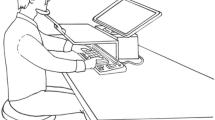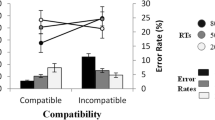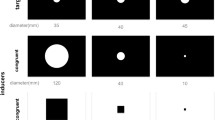Abstract
To measure dynamic visuo-motor coupling within the two hemispheres, we showed observers an animation of a rotating cup. They indicated with left or right buttons when a fixation dot in the center of the animation changed color. For either hand, response times changed continuously with the irrelevant position of the cup’s handle, even when the perceptual asymmetry of the handle was controlled. This spontaneous lateralized motor preparation showed both top-down and bottom-up components and was more pronounced for the right than the left hand. The dynamic affordance method will help understand perception–action coupling in the brain.

Similar content being viewed by others
Notes
We averaged across cup rotations as this factor did not reliably interact with the other factors in RT, all P > 0.18. The only reliable interaction for cup rotation was with response buttons in the error rates, F(2, 38) = 3.48, P < 0.05, MSE = 127.56, eta2 = 0.16, due to a transition from more left to more right errors with later rotations.
References
Aziz-Zadeh L, Koski L, Zaidel E, Mazziotta J, Iacoboni M (2006) Lateralization of the human mirror neuron system. J Neurosci 26:2964–2970
Brainard DH (1997) The psychophysics toolbox. Spat Vis 10:433–436
Craighero L, Fadiga L, Rizzolatti G, Umilta C (1999) Action for perception: a motor-visual attentional effect. J Exp Psychol Hum Percept Perform 25:1673–1692
Desmurget M, Pelisson D, Rossetti Y, Prablanc C (1998) From eye to hand: planning goal-directed movements. Neurosci Biobehav Rev 22:761–788
Fischer MH, Deubel H, Wohlschlaeger A, Schneider WX (1999) Visuomotor mental rotation of saccade direction. Exp Brain Res 127:224–232
Gibson JJ (1979) The ecological approach to visual perception. Lawrence Erlbaum, Hillsdale
Gonzalez CL, Ganel T, Goodale MA (2006) Hemispheric specialization for the visual control of action is independent of handedness. J Neurophysiol 95:3496–3501
Goodale MA, Milner AD (2004) Sight unseen. Oxford University Press, Oxford
Graziano MS, Gross CG (1998) Spatial maps for the control of movement. Curr Opin Neurobiol 8:195–201
Handy TC, Grafton ST, Shroff NM, Ketay S, Gazzaniga MS (2003) Graspable objects grasp attention when the potential for action is recognized. Nat Neurosci 6:421–427
Handy TC, Borg JS, Turk DJ, Tipper CM, Grafton ST, Gazzaniga MS (2005) Placing a tool in the spotlight: spatial attention modulates visuomotor responses in cortex. NeuroImage 26:266–276
Humphreys GW, Riddoch MJ (2001) Detection by action: neuropsychological evidence for action-defined templates in search. Nat Neurosci 4:84–88
Meegan DV, Tipper SP (1998) Reaching into cluttered visual environments: spatial and temporal influences of distracting objects. Q J Exp Psychol A 51:225–249
Milner AD, Goodale MA (1995) The visual brain in action. Oxford University Press, Oxford
Pellizzer G, Georgopoulos AP (1993) Common processing constraints for visuo-motor and visual mental rotation. Exp Brain Res 93:165–172
Phillips JC, Ward R (2002) S-R correspondence effects of irrelevant visual affordance: time Course and specificity of response activation. Vis Cogn 9:540–558
Riddoch MJ, Humphreys GW, Edwards S, Baker T, Willson K (2003) Seeing the action: neuropsychological evidence for action-based effects on object selection. Nat Neurosci 6:82–89
Roy EA (1985) Neuropsychological studies of apraxia and related disorders. North Holland, New York
Tucker M, Ellis R (1998) On the relations between seen objects and components of potential actions. J Exp Psychol Hum Percept Perform 24:830–846
Tucker M, Ellis R (2001) The potentiation of grasp types during visual object categorization. Vis Cogn 8:769–800
Tucker M, Ellis R (2004) Action priming by briefly presented objects. Acta Psychol (Amst) 116:185–203
Woodworth RS (1899) The accuracy of voluntary movement. Psychol Rev Monogr Suppl 3(2(whole no. 13)):1–114
Author information
Authors and Affiliations
Corresponding author
Additional information
MHF was supported by the British Academy through grant SG-39222. We thank the anonymous reviewers for their comments.
Rights and permissions
About this article
Cite this article
Fischer, M.H., Dahl, C.D. The time course of visuo-motor affordances. Exp Brain Res 176, 519–524 (2007). https://doi.org/10.1007/s00221-006-0781-3
Received:
Accepted:
Published:
Issue Date:
DOI: https://doi.org/10.1007/s00221-006-0781-3




